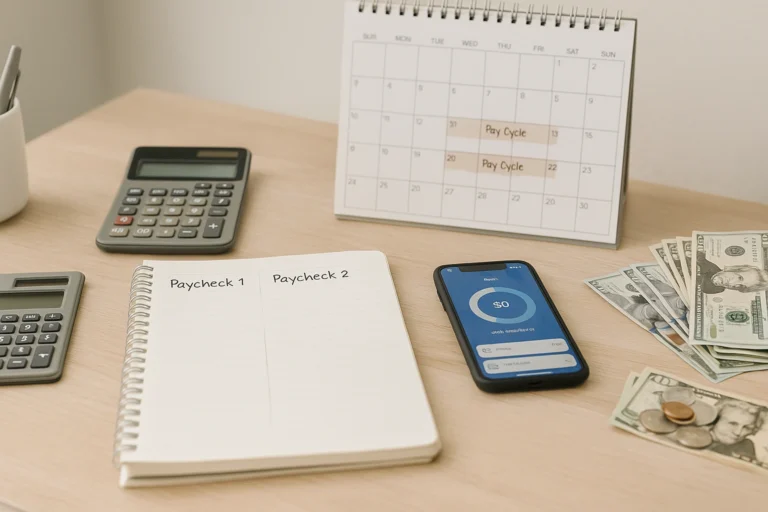Master the 50 30 20 Rule: Track Needs, Wants, and Savings with Our Calculator
50/30/20 Budget Calculator
Let’s face it — managing money can be stressful and overwhelming. That’s why the 50 30 20 rule has become a go-to budgeting method for people who want a simple, stress-free way to manage their finances. Even better, with our easy 50 30 20 rule calculator, you can see exactly how your income should be divided without spending hours crunching numbers.
This budgeting strategy splits your take-home pay into three clear categories: 50% for essentials like rent and groceries, 30% for lifestyle choices and fun, and 20% for savings or debt repayment. It’s flexible, straightforward, and works whether you’re a student, freelancer, or managing a household.
In this guide, we’ll explain how the 50 30 20 rule works, walk you through real-life examples, and show you how to use the calculator to fit this method perfectly into your life. By the end, you’ll have a clear, actionable plan to take control of your money — without feeling restricted or stressed.

How to Use the 50 30 20 Budget Calculator
Using our 50 30 20 rule calculator is super simple. Just enter your monthly take-home income, and the tool will instantly break it down into three categories:
- 50% Needs: Essentials like rent, groceries, utilities, and transportation.
- 30% Wants: Lifestyle choices, dining out, entertainment, and hobbies.
- 20% Savings or Debt: Money set aside for savings, investments, or paying off debt.
You can also adjust the percentages if your situation is a little different—maybe you want to save more or have higher needs—and the calculator will update automatically. Plus, if you want to start over, just hit the reset button to clear all fields and enter new numbers.
It’s a quick, visual, and flexible way to see exactly where your money should go, making budgeting stress-free and tailored to your lifestyle.
RELATED POSTS:
How the 70 20 10 Budget Works?.
Genius Budgeting Hacks to Save More.
The Half Payment Budget Method.
What Is the 50 30 20 Rule?
The 50 30 20 rule is one of the simplest and most effective budgeting methods you can use to manage your money wisely. It was popularized by U.S. Senator Elizabeth Warren in her book All Your Worth, and it’s now one of the most recommended financial strategies for beginners. The idea is simple: every month, you divide your after-tax income into three categories — needs, wants, and savings (or debt repayment).
Here’s what that looks like:
- 50% for Needs: These are your must-haves — rent or mortgage, groceries, utilities, transportation, and basic insurance. Basically, anything you can’t skip or delay paying.
- 30% for Wants: This is where you get some breathing room — eating out, shopping, hobbies, streaming services, or a weekend trip. These are non-essential but keep life enjoyable.
- 20% for Savings and Debt: This chunk goes toward your financial goals — building an emergency fund, paying off loans faster, or investing for the future.
The beauty of this budgeting rule is its simplicity. You don’t need a finance degree or fancy software — just know your monthly income and your spending habits. Once you’ve categorized your expenses, you’ll have a clear view of where your money is going and how to adjust it to meet your goals.
It’s a realistic framework for anyone — whether you’re just starting to budget or looking to get back on track financially. The 50 30 20 budget helps you spend confidently, save consistently, and still enjoy the things you love — all without feeling deprived.
How to Calculate Your 50/30/20 Budget?
Now that you know what the 50 30 20 rule is, let’s break down how to actually use it in real life. It’s simpler than it sounds — and once you do it once, you’ll wonder why you didn’t start sooner.
Step 1: Figure Out Your After-Tax Income
Start with your net or take-home pay — that’s the amount left after taxes, retirement contributions, and deductions. If you’re a freelancer or business owner, estimate your income after setting aside taxes and business expenses. This is your base number for your 50/30/20 budget.
Step 2: Apply the 50/30/20 Budgeting Formula
Now divide your income using this simple budgeting formula:
- 50% – Needs: Housing, groceries, utilities, health care, transportation.
- 30% – Wants: Dining out, shopping, hobbies, subscriptions, travel.
- 20% – Savings or Debt: Emergency fund, debt payments, investments, or savings goals.
For example, if your monthly take-home pay is $3,000, your breakdown would look like this:
- $1,500 for needs
- $900 for wants
- $600 for savings or debt
Step 3: Track and Adjust Your Spending
Budgets are not one-size-fits-all. Use a simple spreadsheet, budgeting app, or even your notes app to track what you’re spending. After a month or two, adjust your categories if needed — maybe your rent is a bit higher, or you want to save more aggressively.
The goal isn’t perfection — it’s awareness and balance. By following the 50 30 20 rule for budgeting, you’ll quickly see where your money goes, avoid overspending, and start feeling more in control of your finances.
Pro Tip:
Automate your savings or debt payments so the 20% portion goes out first. That way, you’re paying yourself before spending on anything else
Why the 50 30 20 Rule Works? (and Why It’s So Popular?)
The 50 30 20 rule isn’t just another budgeting trend — it’s a proven personal finance plan that’s stood the test of time. What makes it so effective is how simple and flexible it is. Instead of tracking every single expense, this budgeting strategy gives you a clear, realistic way to manage your money without stress.
1. It’s Easy to Follow and Stick To
Most people give up on budgeting because it feels too complicated or restrictive. The 50/30/20 budgeting method removes that pressure by dividing your income into just three clear categories — needs, wants, and savings. That’s it.
You instantly know if you’re overspending on non-essentials or not saving enough, and you can adjust without needing a finance degree.
2. It Creates a Balanced Spending Lifestyle
The real magic of the 50 30 20 budget breakdown is balance. It lets you cover essentials, enjoy life’s little pleasures, and build future security — all at once. You’re not cutting out fun or luxury entirely; you’re just keeping it in proportion.
That’s why this simple budgeting system feels more sustainable than most — because it fits real life.
3. It Builds Long-Term Financial Freedom
When you consistently save that 20%, you’re building a habit of paying yourself first. Over time, that money can grow into an emergency fund, investments, or even early retirement savings.
This money management method naturally pushes you toward financial stability and long-term freedom, even if you start small.
4. It Works for Any Income Level
Whether you’re earning $2,000 or $20,000 a month, the 50 30 20 rule scales perfectly. It’s percentage-based, so it adapts automatically to your income. That’s why so many experts, finance coaches, and creators recommend it as the foundation of every personal budget.
In Short:
The 50 30 20 budgeting rule works because it’s clear and flexible. It respects the fact that you have bills to pay, goals to reach, and a life to live — all at the same time.
Real Examples (3 Quick Scenarios)
Below are three realistic ways the 50 30 20 rule looks in practice. Each example uses after-tax income and shows how to split money into needs (50%), wants (30%), and savings/debt (20%). Also explained how to reclassify items like subscriptions, transport, and childcare so your budget matches real life.
Single professional — $3,000 net per month
Breakdown (50/30/20):
- Needs (50%): $1,500 — rent, groceries, utilities, transit, basic insurance.
- Wants (30%): $900 — dining out, streaming, gym, clothes, hobbies.
- Savings/Debt (20%): $600 — emergency fund, retirement contribution, extra debt payment.
Real-life reclassifications:
- If you have a Netflix subscription and a gym membership, ask: do both make life easier (needs) or are they wants? Generally, streaming = want; gym = want or need depending on health needs.
- Transport: if you rely on public transit for work, classify it as a need. Occasional ride-shares for nights out go under wants.
Quick tip: If rent is slightly higher (say $1,200), trim wants first — cut one subscription or reduce dining out to keep the 50% needs cap intact. Or temporarily shift 5% from wants → savings if you have an urgent goal.
Couple/family with mortgage — $6,000 net per month
Breakdown (50/30/20):
- Needs (50%): $3,000 — mortgage, utilities, groceries, childcare or school fees, basic insurance.
- Wants (30%): $1,800 — family outings, subscriptions, non-essentials.
- Savings/Debt (20%): $1,200 — emergency fund, retirement, college fund, extra mortgage principal.
Real-life reclassifications:
- Childcare or school costs are usually needs; that can push the needs bucket high. If needs exceed 50% because of mortgage and childcare, adjust to a 60/30/10 split temporarily — prioritize essentials and debt/savings until you can rebalance.
- Subscriptions for children’s educational apps? Consider them a want unless required for school.
Quick tip: For families, automating savings (20%) into separate accounts — emergency, retirement, and education — helps avoid mixing goals. Revisit budget each school term when childcare costs change.
Student or low-income earner — $1,500 net per month
Breakdown (50/30/20):
- Needs (50%): $750 — shared rent, basic groceries, transport, phone.
- Wants (30%): $450 — small treats, occasional meals out, hobby supplies.
- Savings/Debt (20%): $300 — build a starter emergency fund, pay down small debts.
Real-life reclassifications & priorities:
- If essentials already consume more than 50% (common in tight budgets), flip priorities: ensure essentials and minimum debt payments first, then aim for even a small automatic save (e.g., $50/mo) — progress matters.
- Subscriptions: temporarily pause non-essential streaming or app fees and move that money to savings or debt repayment.
Quick tip: For irregular income students or gig workers, calculate an average monthly net (total last 3 months ÷ 3) and budget from that. Treat any extra month income as bonus — direct it to savings or debt.
Quick wrap — how to classify tricky items
- Subscriptions: Usually wants unless essential for work or education (then tag as needs).
- Transport: Daily commute = needs; occasional rideshares = wants.
- Childcare & school fees: Generally needs for working parents.
- Dining out: Mostly wants, unless it’s work-related travel or required business meals.
Benefits of Using the 50 30 20 Rule
The beauty of the 50 30 20 rule lies in how effortlessly it helps you manage money without stress or confusion. It’s a simple budgeting system that even beginners can stick to — while still powerful enough to guide anyone toward long-term financial stability.
1. Simplicity and Clarity That Actually Works
The reason so many people love the 50/30/20 budgeting rule is its simplicity. You don’t need apps full of charts or complex spreadsheets — just divide your take-home pay into three clear categories: needs, wants, and savings.
This clear structure brings instant awareness of where your money goes and helps you make smarter spending decisions every month. Financial experts often say that the more straightforward your personal finance plan is, the more likely you are to stay consistent — and that’s exactly what this rule delivers.
2. Encourages Savings and Reduces Decision Fatigue
Every purchase or bill doesn’t have to turn into a stressful debate. With this money management method, you already know your limits for each category, so you spend more intentionally. It removes the guilt around small indulgences while still pushing you to save that 20% for your goals.
This small but steady savings habit can build an emergency fund, investments, or even a down payment — all without the mental drain of overthinking every expense.
3. A Perfect Starting Point for Financial Growth
The 50 30 20 budgeting system acts as a foundation before you move to more advanced budgeting tools or investment plans. It’s like training wheels for your finances — giving you structure and balance before diving into detailed tracking or automated investing.
Financial advisors frequently recommend starting with this budgeting rule to understand your spending patterns, develop discipline, and prepare for more complex money strategies later on.
Practical Tips to Make the 50/30/20 Rule Work
Once you understand how the 50 30 20 rule works, the real magic happens when you put it into action. It’s not about strict rules — it’s about finding balance between comfort and progress. Here are a few simple yet powerful ways to make this budgeting system fit your everyday life.
1. Automate Your Savings and Bills
The easiest way to stick to any personal finance strategy is to remove temptation. Set up automatic transfers so a portion of your income (that 20%) goes directly into savings or investments as soon as your pay check hits.
You can also automate recurring payments for rent, utilities, or loan instalments. That way, you avoid late fees and never “accidentally” spend money meant for essentials. Automation turns good financial habits into effortless routines.
2. Trim Your “Wants” Without Losing Joy
Following the 50/30/20 budgeting plan doesn’t mean cutting out fun — it just means being more intentional. If you love eating out, maybe cook at home three nights a week and save those extra dinners for weekends.
The goal isn’t deprivation, but smarter choices. Use tools like spending trackers or apps to see where your “wants” add up, then trim the ones that don’t actually bring joy. This small shift keeps your finances balanced and your lifestyle enjoyable.
3. Renegotiate Big Bills and Monthly Costs
You’d be surprised how much money you can save by simply asking for better rates. Contact your internet, insurance, or mobile service providers and see if they can match competitor pricing or offer a discount for loyalty.
Reducing your fixed expenses means more money for savings — without changing your day-to-day routine. It’s one of the smartest money management moves you can make.
4. Review and Adjust Quarterly
Your financial goals and expenses will change over time — and that’s okay. Every few months, review your budgeting plan to see if your current split still works.
Maybe you got a raise, started freelancing, or faced higher rent — all good reasons to tweak your categories. The 50/30/20 rule is meant to evolve with you, not restrict you.
Conclusion:
The 50 30 20 rule proves that money management doesn’t have to be complicated. With just three simple percentages, you can take control of your income, reduce financial stress, and finally start saving consistently. It’s a realistic budgeting method that works — no matter your income or lifestyle.
Think of it as a one-month experiment and With our 50 30 20 budget calculator, you can instantly see how your money should be allocated between needs, wants, and savings. Treat it like a one-month experiment: track your spending, follow the 50-30-20 split, and notice how much clarity it brings. You’ll quickly identify where your money has been leaking and see how easy it is to balance essentials, lifestyle expenses, and savings once it’s all mapped out.
At the end of the day, the best personal finance plan is the one you can actually maintain — and the 50 30 20 rule is the perfect place to start.






